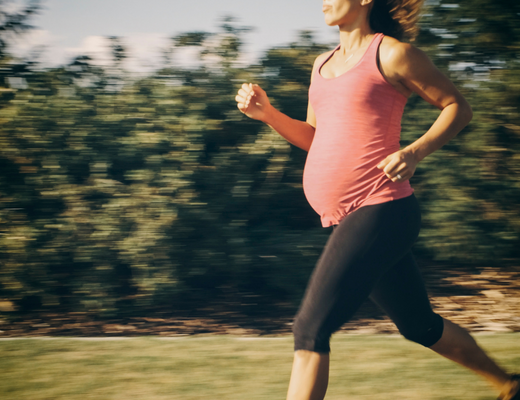We spoke to pre and post-natal fitness expert Holly Lucatello, a health-first personal trainer, F45 coach, and online fitness mentor who sets the record straight on common misconceptions surrounding exercise during pregnancy.
You may have heard common misconceptions surrounding the do’s and don’t of exercise during pregnancy. One of the most prevalent misconceptions is that you may harm baby if working out during pregnancy. However, Holly assures mums wanting to get their body moving that “as long as you don’t have a high-risk pregnancy, then you are completely safe to exercise, in fact, evidence shows that exercise is actually really beneficial for baby.”
Similarly, another common myth is that mums-to-be should avoid lifting anything heavy during pregnancy. “This is an old wives tale” says Holly. “If you have been weight training before pregnancy, you can absolutely continue, but you may just want to bring the intensity down to around 70% of what you were doing before. Do remember that in later trimesters, you are actually already carrying the weight of your baby and placenta around with you (approx. 10-12.5kg)!”. Your baby is very well protected in your womb and the amniotic fluid that surrounds baby acts like a shock absorber when you move around.


There are times in which you may feel unsure of the right thing to do, and with added external pressures, can be made to feel that you’re putting your body first over what’s best for your baby. Holly notes that your growing baby is part of your body, and taking care of yourself is the best thing you can do for baby. You deserve to feel healthy and happy throughout your pregnancy, and exercise can absolutely help with that.
So what are some effective changes to make to my fitness routine as I progress through my first, second, and third trimester?
Trimester 1
Holly advises to first get the go-ahead from your health care professional.
She suggests to continue doing what you were doing prior to pregnancy, but don’t start anything new – and avoid overheating. For instance, if you weren’t a runner before pregnancy, don’t take up half marathons during pregnancy!
Holly suggests bringing the intensity of your workouts down to 70% and listening to your body and what feels right for you and your baby as every woman and pregnancy is different.
In terms of specific exercises, you can carry on as long as you feel ok to do so.
“You deserve to feel healthy and happy throughout your pregnancy, and exercise can absolutely help with that.
Trimester 2
Everything from your first trimester still applies.
In your second trimester, Holly shares that it is best to avoid exercises that have you lying on your back and instead, opt for incline, sitting or standing. Avoid exercises lying on your front too and instead choose standing exercises.
Be mindful of single-leg exercises and balancing exercises as joints are more unstable due to relaxin hormone,
In relation to core work, Holly advises avoiding working the top layer of abs (e.g. crunches and sit-ups) after your first trimester, as over-exerting can contribute to abdominal separation. Instead, focus on your deeper core muscles with exercises like bird dog and side plank.
Trimester 3
Everything for the above two trimesters still applies when moving through into your third trimester.
At this stage, Holly encourages mums-to-be to think about navigating and accommodating a bigger bump. Changes may include adopting a wider stance (e.g. wide stance squat) and avoiding bumping your bump with activities such as rowing, cycling, and kettlebell swings. Holly notes that jumping may be uncomfortable with pelvic pressure and to instead consider low-impact exercises and to continue listening to your body.

What are effective forms of exercise that are practical during pregnancy?
There are many useful forms to exercise to accommodate a growing bump. In fact, prenatal exercise classes are now widely available, including pregnancy yoga, pilates, and swimming classes that get you moving in a safe and considerate way.
Walking is another effective way to get your body moving as your body adapts. Holly suggests you can even take part in resistance training (weight training) and classes like F45 are a great option as you get personalised attention from the coaches with a varied range of exercises and weight selection to suit you. F45 offers many classes across the UK (and globally) and there is abound to be a team near you.
Holly also suggests simple pelvic floor exercises to help to strengthen pelvic muscles making them stronger during pregnancy. As baby grows, more pressure is applied to the pelvic floor muscles, making them weaker. They also tend to weaken during childbirth due to the pressure of labour.

Working on strengthening these muscles is a great way to reduce the risk of this happening. Strengthening your pelvic floor muscles can also help avoid bladder issues and other similar experiences post-birth. A pelvic floor exercise can include short squeezes, and long squeezes (10secs). Holly recommends the NHS Squeezy Pelvic Floor App to guide and track your progress.
Are there any forms of exercise I should avoid during pregnancy?
In the later stages of your pregnancy, you may want to think about avoiding rowing, cycling, or any activity in which there is a risk of falling over.
Holly also advises avoiding anything that could potentially bump your bump (think high-contact sports like football).
Once you reduce actions that minimize the risk of injury to you and your bump, you are safe to do most other exercises and Holly believes you absolutely should if you can! She notes that “it is amazing for both you and baby to exercise during pregnancy. The benefits may include improved flexibility and the relieving of aches and pains (especially back pain). Exercise during pregnancy may also help to strengthen your pelvic floor, resulting in more stamina during labour, and may even help to speed up post-birth recovery. Not to mention, exercising is a fantastic way to boost your energy & mood.
How soon after giving birth can I resume regular exercise?
Your type of birth will determine how quickly you can get back to exercises post birth. For instance, the recovery time tends to be longer for C Sections. Holly advises starting slow and gently as your body has been through a lot. Really take the time to listen to your body.
If you have suffered from abdominal separation, you will need to avoid working the top layer of your abs, such as with sit-ups and crunches.
If you are breastfeeding, you continue to produce relaxin so you will need to be careful with balancing exercises as joints may be less stable. You may also want to consider pumping milk before a workout.
If you are struggling with training during your pregnancy and don’t know where to start, Holly highly recommends seeking out a pre and post-natal trained professional in your area. Holly has worked with many women during different stages of their pregnancy, empowering them and allowing them to feel strong during their pregnancy and beyond.
Holly Lucatello is a Level 3 Award in Supporting Pre and Post-Natal Clients specializing in health-first personal training and online coaching. She focuses on training clients in a sustainable and holistic way focusing on strength gain and confidence.
Follow Holly Lucatello on Instagram @holly_health.first.fitness and get in touch to learn more. Holly offers both face-to-face sessions and online coaching.
Want to keep up to date with our future blogs like this one? Subscribe to our mailing list for more tips and special offers you surely won’t want to miss!





No Comments